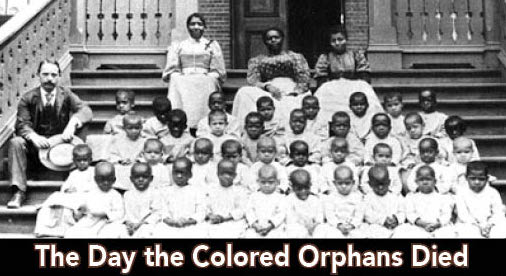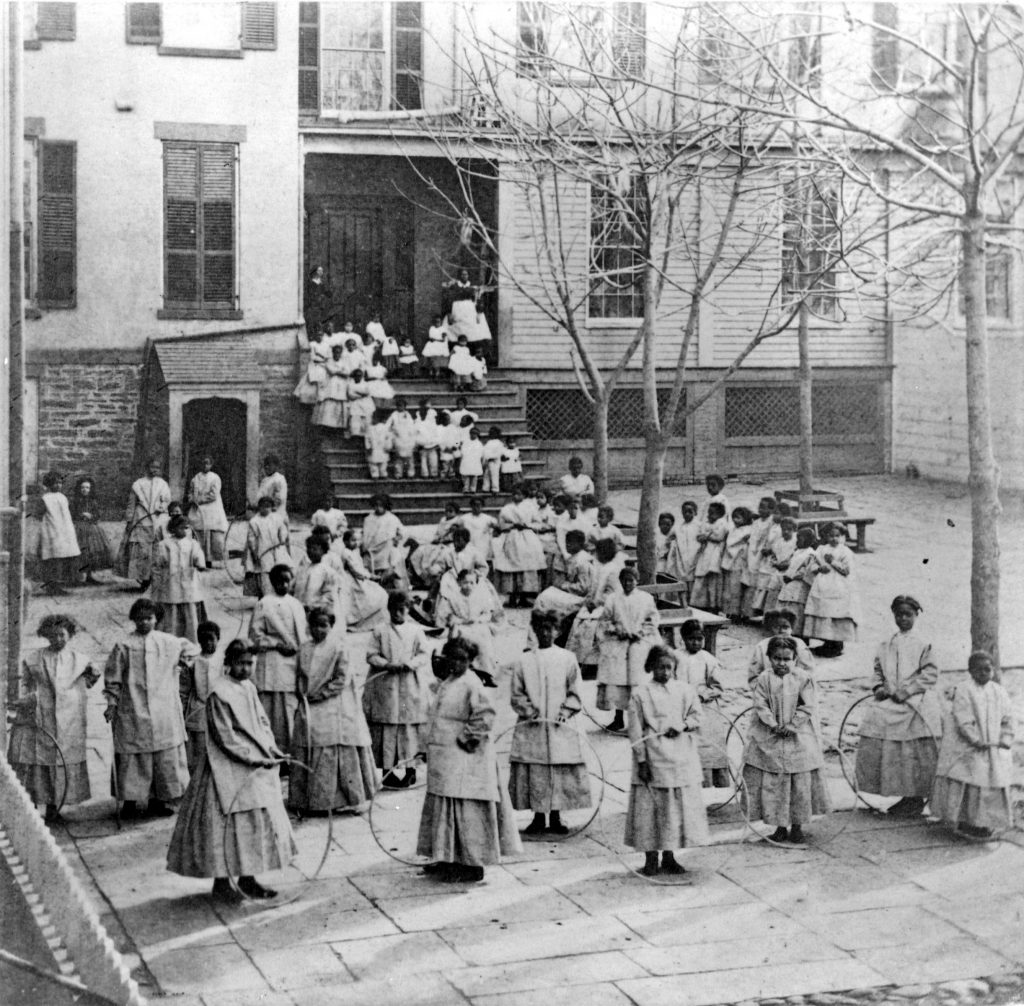The Day the Colored Orphans Died
White racial terrorism bleeds from the very foundation of white American society. New York City—NOT the South—was the location of possibly the bloodiest of the many racial massacres against Blacks, Indians, and Asians in the United States. When, in 1863, Uncle Sam came to the state of New York looking to fill the ranks of the Union army, white males violently objected. They had also been told that the war was being fought “for niggers” and this brought them to a boil.
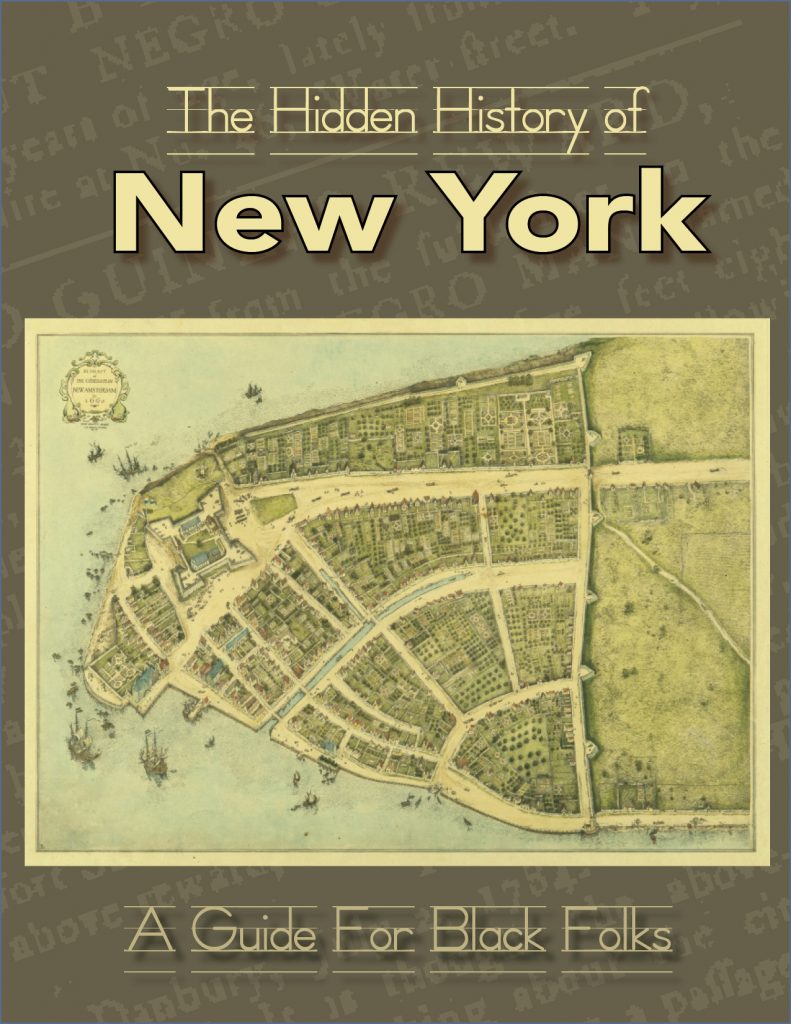
The city’s contemptuous, mostly Irish, immigrants were too cowardly to confront Uncle Sam or the white merchant class, in whose interest the war was really waged. Instead, the vulnerable Black residents were scapegoated in the most vicious way.
A Carnival of Violence: For three days beginning on July 11, 1863, 70,000 treasonous New York whites sacked stores, burned homes, and massacred Blacks with wild abandon. 2,000 New York policemen had no effect and reports proved that they sometimes—as with Abner Louima, Amadou Diallo, Sean Bell, and Eric Garner—joined in the slaughter. Willard A. Heaps provides an overview of the harrowing scene:
…the crowds roamed the city without pause in a continuous orgy of destruction. They committed every sort of crime—murder, lynching, looting, and burning. One of the city’s newspapers correctly called the riots “a carnival of violence.”
Whites packed the street for twelve solid blocks, and within an hour the entire block from Forty-sixth to Forty-seventh streets was in flames. According to the New York Times, the atrocities committed against Blacks “were at least as grotesque as anything that ever emanated from the Deep South.” Rioters swarmed into hotels and beat up Black bellboys and waiters. The superintendent of police was “beaten into insensibility,” as police were outnumbered some 200 to 1. The descriptions of the massacre are horrifying. Below is a sample of the violence endured by Blacks during the 4-day pogrom.
- William Mealy and Matthew Zweick alternately beat, kicked, and stoned James Costello, a Black man. They trampled his body, and hanged him. They then dragged him to a mudhole, then immersed him in water and emptied a barrel of ashes over his head.
- George Glass yanked crippled Black coachman Abraham Franklin and his sister Henrietta from their rooms, beat the girl and dragged Franklin through the streets and hanged him from a lamppost. The military arrived and cut down Franklin’s body, but when the soldiers departed, the corpse was hoisted up again with cheers for Confederate president Jefferson Davis. Patrick Butler then dragged the body through the streets by the genitals, hanged him again, and then cut off his fingers and toes.
- Bands of white boys “marked” the houses of Black residents by stoning the windows. The boys later returned with their male elders to pull out the Black tenants and complete the destruction.
- Democratic politician William Cruise gave straw and matches to a gang of white boys and led them around the corner to the rooms of William Derrickson, a Black laborer. Derrickson escaped but his son Alfred was pulled out onto the street, stripped, and beaten. A fire was started under a lamppost, and Alfred would have been burned to death were it not for the intercession of area residents who chased the lynchers away.
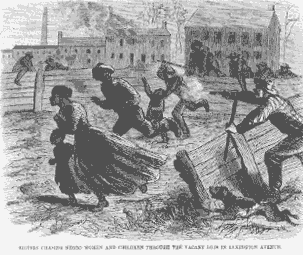 Black workingman Charles Jackson was beaten and nearly drowned.
Black workingman Charles Jackson was beaten and nearly drowned.- Jeremiah Robinson, a Black man trying to escape to Brooklyn, was beaten senseless and thrown into the East River.
- The owners of a waterfront establishment that catered to Black laborers were stripped and threatened with hanging.
- Black sailor William Williams was assaulted when he walked ashore at an Upper West Side pier to ask directions. As he was forced to prostrate, each gang member jumped him, smashed his body with a cobblestone, and finally planted a knife in his chest to the glee of onlookers.
- Whites invaded a house on East 27th Street and killed W.H. Nichols, a young Black man who was trying to defend his elderly mother. Unsatisfied, they snatched a newborn Black baby and hurled the child out of the window.
- Several hundred white men seized a helpless Black man, beat him into insensibility, hanged him from a tree, hacked his body, and finally built a fire to roast the corpse.
- A Black man was knocked to the ground and held down while a white man repeatedly dropped a twenty-pound rock on his head.
- Three Blacks were lynched on the site of the present Pennsylvania Railroad Station while “a gang of bestial women milled about the dangling bodies of the black men, gashing their flesh with knives, while more than 5,000 men cheered them on.”
- On Staten Island fifty white men beat a lame Black man who was unable to follow his friends into the woods.
- A Black man was hanged from a tree on Clarkson Street. A gang of white men and boys built a fire under him, “dancing wildly around the roasting flesh.”
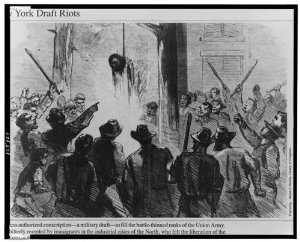
Those unable to flee bore the brunt of the attack. Black men, women, and children were “tortured and slaughtered.” Apartments that housed Black families were torched, and the victims’ furniture demolished and burned in sidewalk bonfires. According to the Herald, some 3,000 Blacks gathered about a relief station. “The unfortunate darkies exhibited all the evidence of extreme hunger, and appeared to be suffering greatly from fear.” Blacks were chased and cornered and strung up and tortured. “Irish biddies knifed the flesh of hanged Negroes, poured oil into the wounds, set fire to the oil, danced under the human torches, and sang obscene songs.” A few whites offered shelter to Blacks who were being pursued by rioters, though most doors were slammed tight.
The Attack on the “Colored Orphan Asylum”: There was one atrocity that exceeded even the basest of white savagery: the attack on the Colored Orphan Asylum in New York City.
The home of last resort for about 250 Black children, the orphanage was a large institutional building on Fifth Avenue between 43rd and 44th streets. When 3,000 marauders set upon the building, there seemed to be little doubt that most of the children would have been butchered alive if they had not been led out a rear entrance while the mob was breaking down the front door.
In the panic twenty children were cut off from the main group of orphans, and on those unfortunates the Caucasians quenched their appetite for blood and melanin. One little Black girl, who had been lost in the confusion, was discovered trembling under a bed. She was pulled out and beaten to death. Ten-year-old orphan Jane Barry was killed when a bureau, dropped from the window of an upper floor, landed on her head.
Rabid whites smashed furniture, uprooted trees, shrubbery, and fences before they burned the orphanage to the ground. One observer noted, “The crowds’ desire [was] not merely to destroy but to wipe clean the tangible evidence of a black presence.” There was no saving the building—the crowd had cut the hoses of the arriving fire companies.
Counting the Black Bodies: When the smoke cleared, as many as 2,000 people were dead and 8,000 wounded. More than 100 buildings were burned down, and about 200 others were damaged and looted. The property loss “has been estimated variously at from $1.5 to $5 million.” Edward Robb Ellis provides this remarkable passage in The Epic of New York:
No one will ever know exactly how many people were killed. The New York Post said that the bodies of rioters were boated across the East River and buried secretly at night. Governor Seymour, who tried to minimize the tragedy, told state legislators that “more than a thousand” civilians, policemen, and soldiers had been slain. Police Superintendent Kennedy, after recovering from his injuries, told G. T. Strong that 1,155 persons had been killed—not counting those smuggled to their graves. Social historian Herbert Asbury wrote that “conservative estimates placed the total at two thousand killed and about eight thousand wounded, a vast majority of whom were rioters.” Four days of rioting in New York City produced casualties numbering almost half the total of Americans killed in the American Revolution, just about as many as perished in the War of 1812, and more than all the battle deaths in the Mexican War.
Hostilities only increased after the pogrom. Blacks lost their jobs from fearful employers, were denied work, and faced intensified discrimination and continued segregation. By 1865, New York City’s Black population was only 10,000, down 20 percent from the 1860 total.
The mayhem was further endorsed by the “punishments” imposed by the sympathetic judges. Of the estimated 70,000 hoodlums, only a few received minor sentences.
Read the 2016 re-released The Hidden History of New York: A Guide for Black Folks, Kindle Edition, by The Reclamation Project. This book exposes New York’s hidden past, including the Manhattan slave revolts, slavery on Long Island, the Wall Street slave market, and New York bankers’ investment in southern plantations. Additionally, this book includes the most comprehensive list of New York slave owners ever published.

